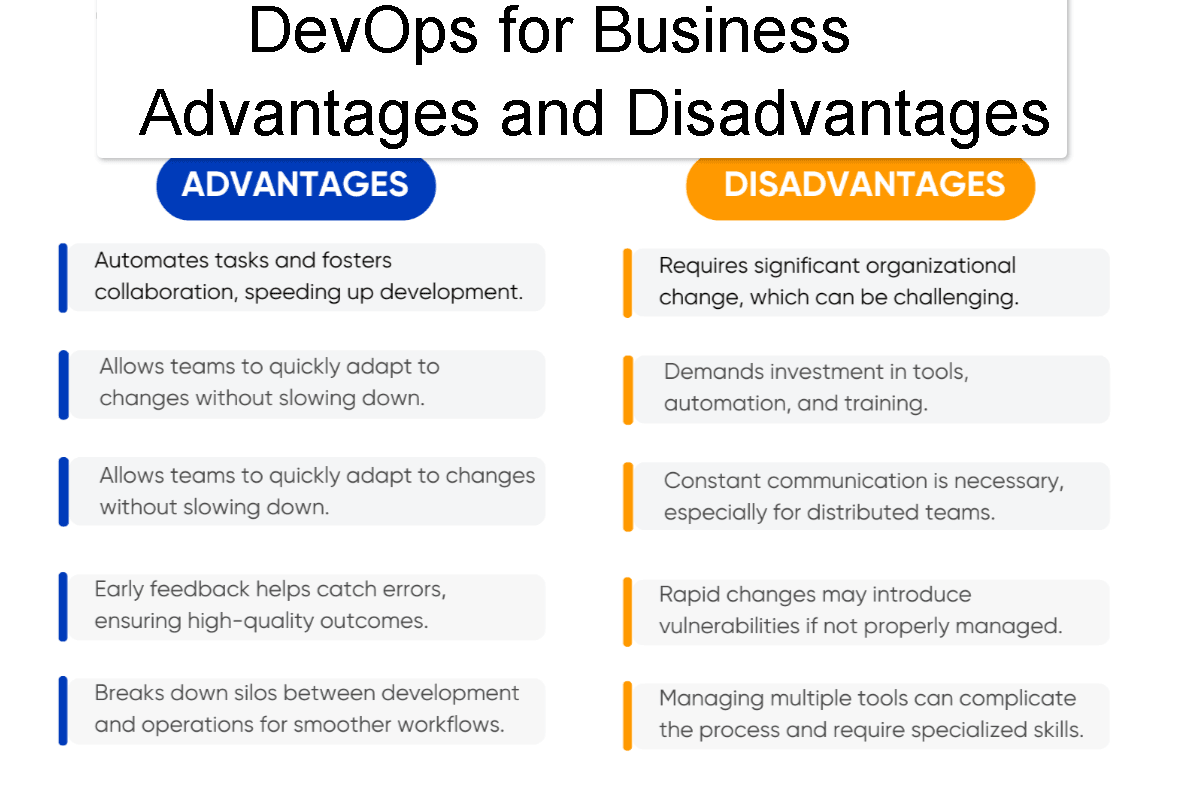
DevOps for Business Advantages and Disadvantages
In the constantly changing landscape of digital technology as well as technological change, DevOps has emerged as an essential method for software development and IT operations. By combining operations and development, DevOps is designed to enhance collaboration, improve the speed of software delivery and improve overall efficiency. Many industries are using DevOps to remain ahead of the competition. Like all methodologies it has its advantages and drawbacks. This article outlines the advantages and drawbacks of using DevOps for business, backed by feedback from users and expert advice.
What’s DevOps?
DevOps refers to a set of tools, practices, and philosophies of culture aimed to enhance the collaboration of software developers (Dev) as well as IT operational (Ops). Through automation and integration of procedures, DevOps enables faster development cycles, better quality software and more secure deployment.
Benefits of DevOps for Business
1. Speedier Time-to-Market
DevOps helps to facilitate the continuous integration and delivery (CI/CD) which allows businesses to roll out new software and updates regularly and more consistently. This gives businesses an competitive edge, especially in fields that demand rapid technological advancement.
2. Improved Collaboration
By removing the barriers between the operations and development team members, DevOps fosters better communication and collaboration. This helps teams can work towards the same objectives, which results in more efficient processes and less bottlenecks.
3. Improved Reliability and Quality
Tools for automated testing and tracking that are integrated into DevOps pipelines allow you to identify and eliminate issues earlier during this process of development. This results in better-quality software and less issues after deployment which improves the customer experience.
4. Scalability
DevOps practices allow businesses to increase their efficiency in scaling their operations. Infrastructure as Code (IaC) lets teams manage and provide resources in a way that is programmatically to ensure that systems can manage the increasing demands without causing downtime.
5. Cost Savings
Automation of repetitive processes, for example tests and installation, cuts down on the manual effort required and costs associated with it. DevOps reduces downtime as well as improves the reliability of systems, thereby saving cash in the long run.
6. Improved Customer Experience
With quicker delivery times and improved software quality companies are able to respond to the needs of customers more efficiently. Continuous feedback loops guarantee that complaints and suggestions from customers are dealt with promptly.
7. The flexibility and Innovation
DevOps allows agile methods which allows businesses to experiment with new concepts, roll out new features in a gradual manner, and adjust to market trends rapidly.
Advantages of DevOps for Businesses
1. Cultural Shift Challenges
The implementation of DevOps requires a significant culture change. Teams must adapt to new methods of working which could result in tension or conflict in the initial phase of transition.
2. The Initial Investment
The process of setting up an DevOps infrastructure requires upfront expenses for training, tools and reorganization. Small and medium-sized enterprises (SMBs) might be unable to find the resources needed to the initial setup.
3. Tool Overload
With the abundance of DevOps tools to choose from, selecting the most appropriate one could be a daunting task. The process of integrating and managing several tools can become complicated and demanding.
4. Security Issues
The speed and efficiency of DevOps may sometimes leave out security weaknesses. If they are not properly integrated with DevSecOps methods, companies risk opening their systems to possible security threats.
5. Complexity of Large Companies
For large companies that have multiple teams and systems that are not up to date implementation of DevOps isn’t easy. Moving diverse teams and groups existing systems to the DevOps framework usually requires a lot of time and effort.
6. Relying on Automatization
Automation is an essential element of DevOps However, relying too heavily on it can cause problems if the automated procedures fail or aren’t properly configured.
real-world feedback on DevOps
The feedback of users about DevOps implementation differs depending on the size of the business or industry as well as its level of experience in implementing the methodology. Below is a list of the most common themes derived from feedback through online platforms and users’ experiences.
Positive Feedback
- Increased Productivity Teams report that automated workflows and simplified workflows drastically reduce development time and operational expenses.
- Better Software Quality Business owners are impressed by the ability to spot and correct issues early during the process, leading to less problems post-release.
- Flexibility Users praise the ease of adjusting to market needs by leveraging DevOps its agile nature.
Negative Feedback
- Learn Curve Certain businesses are faced with challenges when it comes to training their employees to adjust to the latest tools and methods.
- integration complexity organizations with outdated systems have issues the integration of DevOps practices into existing workflows.
- Cost concerns SMBs often point out that the initial investment in training and tools could be a hindrance to the adoption.
Comparison Table Advantages over. disadvantages in DevOps for Business
| Advantages | Negatives |
|---|---|
| Faster time-to-market for software delivery | It requires a major cultural change |
| Collaboration between teams has been improved | A large initial investment in equipment and training |
| Improved software quality and reliability | A wide range of tools to choose from |
| Scalability of Infrastructure through Code | Security concerns that could arise without DevSecOps |
| Cost savings from automation | Complexity of large corporations |
| Faster and more efficient customer service with frequent updates | Automation is too dependent. |
| Innovations are flexible and market change | The learning curve for teams |
Essential Tools for the DevOps ecosystem
The most well-known tools that companies employ for implementing DevOps practices are:
- CI/CD Tools: Jenkins, GitLab CI, CircleCI
- Containerization: Docker, Kubernetes
- Configuration Management Ansible, Chef and Puppet
- Monitor and Logging: Prometheus, ELK Stack, Datadog
- Version Control Git, Bitbucket
- Cloud Platforms: AWS, Azure, Google Cloud
The best combination of these tools will depend on your business’s requirements, current infrastructure, as well as team expertise.
How to Surmont DevOps Obstacles
- Spend money on training Your teams should be equipped with the capabilities and expertise to work efficiently in an DevOps environment.
- Start small Start by launching small pilot projects that test DevOps methods before scaling to the whole organization.
- adopt DevSecOps Incorporate security in the DevOps pipeline to identify potential security issues.
- Select Tools Carefully Select tools that meet your goals for business and make sure they are compatible with your existing systems.
- Create a Culture of Collaboration Encourage cooperation and open communications between the operations and development teams, in order to lessen resistance.
Conclusion
DevOps is a highly effective method that has the potential to transform how companies approach IT and software development. Its benefits – faster delivery cycles and improved quality, cost savings and better collaboration make it a desirable option for companies looking to remain ahead of the curve. However, issues like resistance to culture and high initial investment and tool complexity need careful planning and implementation.
If you are a business contemplating DevOps it is essential to evaluate its benefits and disadvantages within the context of their particular requirements and goals. If implemented correctly, DevOps can serve as catalysts to improve operational efficiency and innovation and can lead to long-term success in a digital environment.

















Average Rating